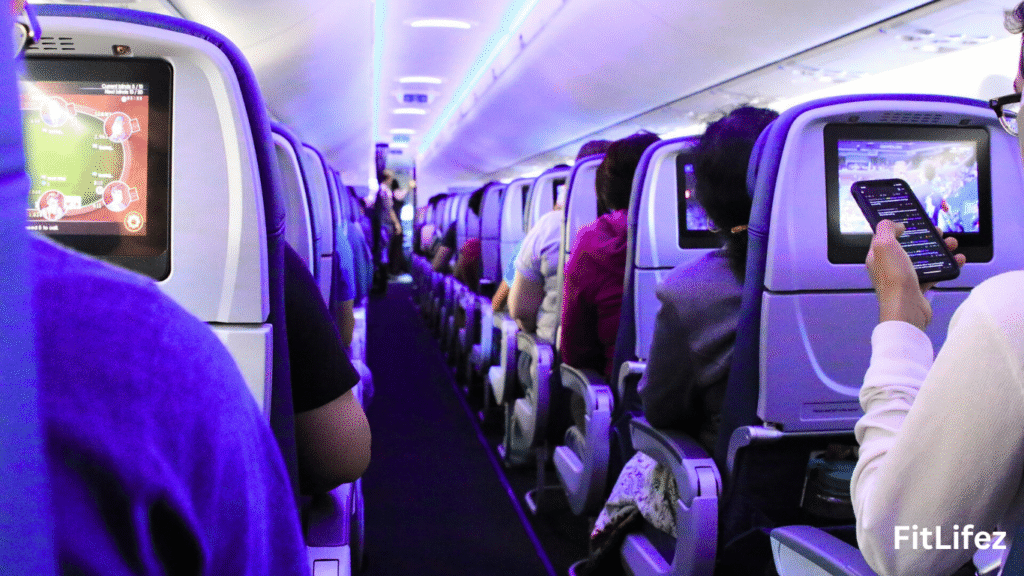Introduction
Traveling by air can be an exciting adventure, offering the promise of new destinations and experiences. However, for many, the journey itself can be a challenge, especially when it involves long-haul flights. One of the most common difficulties faced by travelers is getting a good night’s sleep on an airplane.
As an experienced article writer with over five years in the field, I, Muhammad Shakeel, am here to guide you through some effective strategies to ensure you arrive at your destination well-rested and ready to explore. You can find more health and travel tips on my website, [FitLifez](https://fitlifez.com/).
Understanding the Challenges
Before delving into tips, it’s essential to understand why sleeping on airplanes is problematic for many. The cramped seating, noise, light, and the general hustle and bustle of an airplane cabin can all disrupt sleep. Add to this the irregular schedules, time zone changes, and potential jet lag, and you have a recipe for restlessness. However, with the right strategies, these hurdles can be overcome.
1. Choosing the Right Seat
The first step to ensuring a good rest is selecting the right seat. Your seat choice can significantly affect your comfort and ability to sleep.
Window vs. Aisle
Window Seat: Offers a place to rest your head, minimizes disturbance from other passengers, and lets you control the window shade to manage light exposure.
Aisle Seat: Provides easy access for movement but often results in disturbances from fellow passengers.
Avoiding High-Traffic Areas
Seats near the galley or restroom are often noisier due to passenger movement and crew activities. Opt for a seat midway between these areas if possible.
Exit Rows and Bulkheads
While these seats offer more legroom, they may have fixed armrests, which can limit your space to spread out. Additionally, the proximity to the galley can result in more noise.
2. Preparing for Sleep
Preparation begins even before you board the plane. Here are steps you can take to prime yourself for sleep:
Adjusting Adjusting Your Schedule
Try to slowly adjust your sleep schedule to your destination’s time zone a few days before your flight. This can help reduce the impact of jet lag and make it easier to sleep at the right times during your journey.
Packing Essentials
Neck Pillow: A good neck pillow provides support and helps prevent neck strain.
Eye Mask: Blocks out light, helping to simulate a nighttime environment.
Earplugs or Noise-Canceling Headphones: These can block out ambient noise and create a quieter environment conducive to sleep.
Blanket or Shawl: Airplane cabins can get cold, and having a blanket can keep you warm and comfortable.
Dressing Comfortably
Wear loose-fitting, comfortable clothing. Layers are beneficial due to varying cabin temperatures.
3. Managing the In-Flight Environment

Once on board, setting up your environment is key to facilitating sleep.
Creating a Sleep-Friendly Space
Recline Your Seat: As much as possible without disturbing others, to find a comfortable position.
Use Your Pillow and Blanket: Set them up immediately to settle into a comfortable position.
Controlling Light and Sound
Close the Window Shade: If you’re in a window seat, close the shade to block out light.
Use Eye Masks and Earplugs: To minimize distractions from light and noise.
Limiting Distractions
Switch Off Electronics: The blue light emitted from screens can disrupt your ability to fall asleep. Use devices only if necessary, preferably with blue light filters.
Avoid Alcohol and Caffeine: Both can interfere with sleep quality. Opt for water or herbal teas instead.
4. Relaxation Techniques
Incorporating relaxation techniques can significantly enhance your ability to sleep on a plane.
Breathing Exercises
Deep, slow breathing can help calm your nervous system and promote relaxation.
Guided Meditation or Sleep Apps
Consider using apps that offer guided meditations or soothing sounds. These can help distract your mind from the environment and ease you into sleep.
Progressive Muscle Relaxation
This involves tensing and then relaxing each muscle group in your body, starting from your toes and working your way up. It can help reduce physical tension and promote relaxation.
5. Timing Your Sleep
Understanding when to sleep is just as important as how you sleep.
Aligning with Your Destination
Try to sleep according to the time at your destination. This strategy helps your body start adjusting to the new time zone even before you land.
Short Naps for Short Flight
If you’re on a short flight, a brief nap can refresh you without leaving you groggy. Aim for a 20-30 minute nap to boost alertness.
6. Meal and Drink Considerations
What you consume before and during your flight can impact your ability to sleep.
Eating Light
Heavy meals can make you uncomfortable and disrupt sleep. Opt for a light, balanced meal before boarding.
Staying Hydrated
Dehydration can worsen fatigue. Drink plenty of water before and during your flight, but be mindful not to overconsume right before you intend to sleep to avoid frequent restroom trips.
7. Dealing with Jet Lag
Jet lag is a common challenge, especially for long-haul flights crossing several time zones. Here’s how to mitigate its effects:
Gradual Shift
As mentioned earlier, gradually shifting your sleep schedule before departure can help.
Exposure to Natural Light
After landing, try to expose yourself to natural light as much as possible. This can help reset your internal clock.
Melatonin Supplements
Consider using melatonin supplements to help adjust your sleep cycle. It’s best to consult with a healthcare provider before use.
Conclusion
Sleeping on an airplane can be a challenge, but with the right strategies, it’s entirely possible to get a good rest and arrive at your destination refreshed. By carefully selecting your seat, preparing adequately, managing your in-flight environment, and timing your sleep effectively, you can overcome many of the common obstacles to sleeping on a plane. For more travel and health tips, feel free to visit my website, [Fit Lifez](https://fitlifez.com/). Safe travels and sweet dreams!

